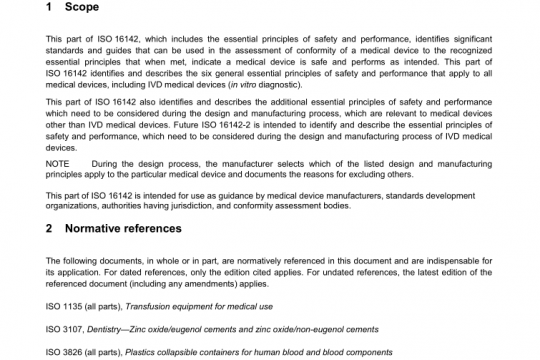AAMI ISO 10993-16 pdf free download
AAMI ISO 10993-16 pdf free download.Biological evaluation of medical devices—Part 16: Toxicokinetic study design for degradation products and leachables.
4 Principles for design of toxicokinetic studies
4.1 Toxicokinetic studies should be designed on a case-by-case basis, see Annex A.
4.2 A study protocol shall be written prior to commencement of the study. The study design, including methods, shall be defined in this protocol. Details of areas to be defined are given in 4.3 to 4.7 and in Clause 5.
4.3 The results of extraction studies (see ISO 10993-12 [1] and ISO 10993-18 [2]) should be considered in order to determine the methods to be used for toxicokinetic studies. Information on the chemical and physicochemical properties, surface morphology of the material and biochemical properties of any leachable should also be considered.
NOTE The extent and rate of release of leachables depend on the concentration at the surface, migration to the surface within the material, solubility and flow rate in the physiological milieu.
4.4 It is recommended to undertake toxicokinetic studies with a characterized leachable or degradation product that has the potential of being toxic. However, the performance of toxicokinetic studies on mixtures is possible under certain conditions. An extract liquid (see ISO 10993-12 [1]), or a ground or powdered form of the material or device, may be used in exceptional circumstances and shall be justified in the study design.
4.5 Analytical methods shall be able to detect and characterize degradation products, leachables and metabolites in biological fluids and tissues.
For analytical methods, other parts of ISO 10993 shall be used as relevant. The methods shall be fully described in the study report (see 5.1.10). Quantitative analytical methods shall be specific, sensitive and reproducible (see ISO 10993-18 [2]). Limit of detection/quantification shall be defined and justified.
Validation/qualification of the method shall be performed.
4.6 The study design shall state the physiological fluid, tissue or excreta in which analyte levels will be determined. Analyte recovery from the matrix shall be documented.
NOTE Blood is convenient to sample and thus is often the fluid of choice for kinetic parameter and absorption studies. It is necessary to specify whether analysis is on whole blood, serum or plasma and to provide validation of this choice. Binding to circulating proteins or red cells can be determined In vitro.
4.7 There should be sufficient data points with adequate time intervals to allow determination of kinetic parameters. In theory, this should cover several terminal half-lives; in practice, the constraints of the analytical method may necessitate a compromise.
5 Guidance on test methods
5.1 General considerations
5.1.1 The study should be performed on an appropriate sex and species; consider utilizing the same species used for the systemic toxicity studies. The animal welfare conditions should be as recommended in guidelines for the care and use of animals (see ISO 10993-2 [3]).
5.1.2 A non-radiolabelled test substance may be utilized provided that suitable validated assay procedures for the test substance in the relevant samples exist and the metabolism of the test substance is well characterized.
5.1.3 If necessary, the test substance should be radiolabelled in a metabolically stable position, preferably with 14C or 3H, and of suitable radiochemical purity (>97 %). When using 3H, the possibility of tritium exchange should be considered. The specific activity and radiochemical purity of the test substance shall be known and reported.AAMI ISO 10993-16 pdf download.
Other IEC Standards
-

ANSI AAMI ISO 16142-1 pdf free download – non-IVD medical devices and guidance on the selection of standards
AAMI standards list DOWNLOAD -

ANSI AAMI ISO 16142-2 pdf free download – General essential principles and additional specifc essential principles
AAMI standards list DOWNLOAD


